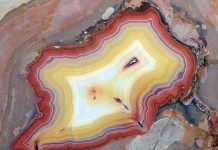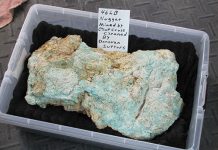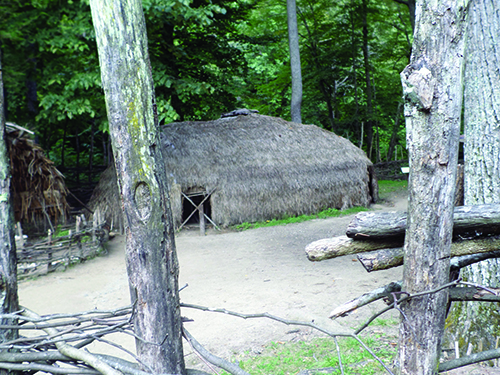
Editor’s Note: This is the second in a two-part series about the Natural Bridge of Virginia. Be sure to enjoy Part I >>>
By Deborah Painter
I visited the Natural Bridge of Virginia in August of 2019 with my friend David Hawk, who wanted to see it for some years but had never been able to spare the time when he was in this part of Virginia. We wanted to collect some representative dolostone also. Near U.S. Route 11, approximately 0.47 miles north of the visitors center and at latitude 37° 38’ 05.65” North and longitude 79 ° 32’ 37.76 West, we were able to collect some loose specimens of dolomite on private land wherein permission was obtained from the owner. They displayed interesting features that looked like bits of Chepultepec limestone and a few small white markings.
Dolostone is a durable rock but, like all lime-based sedimentary rock, is vulnerable to chemical and physical weathering. The stage road of the 1800s that crossed the Bridge then became a paved road for automobiles and trucks as the stage road became absorbed into a portion of the main north-south roadway corridor through the Shenandoah Valley, U. S. Route 11. This road still uses the Bridge as an official crossing.
Yet, even with the utilization of regular U.S. government-mandated bridge inspections beginning in the late 1960s, no formal inspection of the stone span was carried out until very recently to determine if it was suitable for sustained use in the era of large diesel trucks. The construction of Interstate 81 from New York south to Tennessee was to some degree helpful; some of the heavy traffic that once used the Bridge would use the modern multilane highway.
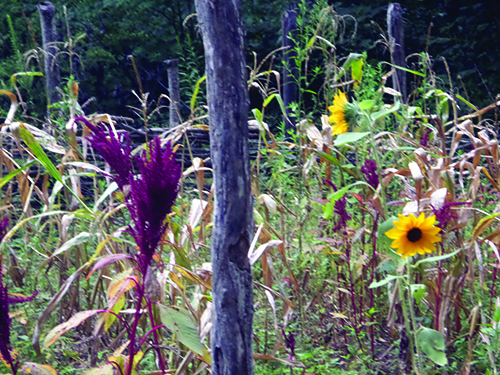
MODERN PRESERVATION EFFORTS
One would think that this scenic wonder would always be afforded the preservation worthy of its historic significance. The private owners of the Natural Bridge at Cedar Creek did their best to preserve the saltpeter cave and native vegetation, including the extremely old arbor vitae trees along the trail from the Visitors Center to Lace Falls, but their ability to keep the gorge free of vandals and graffiti artists and to preserve the natural resources of the land to the north, south, and west was limited. They also had no control over highway use.
Angelo Puglisi was the most recent private owner, having purchased the complex, including the Natural Bridge Hotel, in 1988. When he made the announcement in 2013 that he planned to sell the property, there was the possibility that it might be divided up into smaller tracts with multiple ownership. A zipline concession approached him about purchasing rights to run a zipline from the top of the Bridge. This sort of over commercialization would harm its scenic, historic, and natural assets. Rockbridge County and the cities of Buena Vista and Lexington passed resolutions stating that the Bridge was an icon for the Commonwealth and better stewardship was needed. Land trusts throughout the United States worked together. The Rockbridge Area Conservation Council and the Valley Conservation Council formed the Friends of the Natural Bridge.
A nonprofit Virginia Conservation Legacy Fund was headed by Roanoke, Virginia, resident and healthcare executive Tom Clarke. Mr. Puglisi donated 187.8 acres, and the group paid for another 1,299.7 acres with a loan from the Virginia Clean Water Revolving Loan Fund from the Virginia Resources Authority and the Virginia Department of Environmental Quality. Thanks to Mr. Puglisi and the Virginia Conservation Legacy Fund, the Natural Bridge and Visitors Center, as well as hundreds of acres surrounding them, became part of the state parks system in 2016. The Natural Bridge Hotel and Conference Center remains in private ownership by Mr. Clarke’s nonprofit organization.
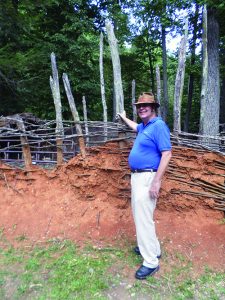
Because the Bridge was now part of the Virginia Department of Conservation and Recreation, the Department made an agreement with the Virginia Department of Transportation to test the Bridge at last. Geologists were subcontracted in early autumn of 2017 to perform varied methods of nondestructive testing, including electrical resistivity, geophones (small seismic sensors), and Ground Penetrating Radar testing.
The conclusion of the testing is that fractures and internal voids have developed in the dolostone. It is inconclusive whether this is the result of vehicular use, but to err on the side of caution, the Virginia Department of Transportation is studying alternative routing for this segment of U. S. Route 11, diverting it from the Bridge, and is writing an environmental document toward that end.
For a few decades prior to the sale of the tourist complex, public visitation had decreased. But the establishment of the Natural Bridge State Park boosted visitor use dramatically. The park rangers furnish a vehicle that will drive tired visitors back to the visitors center when they return to the Bridge at the end of their hike from Lace Falls. This might account for some of the increased visitor traffic, since there are four flights of timber stairs leading from the canyon back to the crest of the hill!
Our August 2019 trip to Natural Bridge State Park afforded me many pleasant surprises after not visiting this beautiful site for a few decades. The price for visiting, $14 per person over 13 years of age in the 1990s, is now $8. The vehicle ride is included, although during the COVID-19 health crisis it has been temporarily discontinued. Signage along the trail now prohibits visitors from entering the saltpeter cave to avoid disturbing roosting or hibernating bats. This prohibition is strictly enforced. Other sensitive habitat areas are marked “no trespassing.”
Another addition is a recreation of a Monacan Indian village along the trail, said village’s restoration being supervised by descendants of the Native Americans who had camped and lived in the gorge.
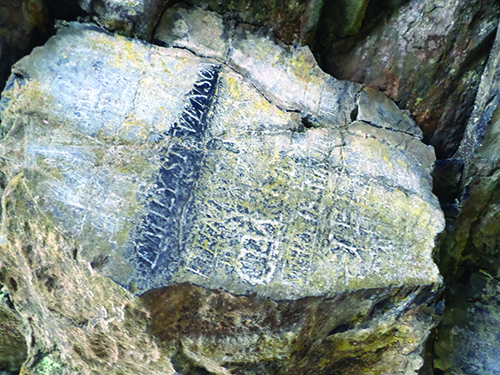
The State Park is located at 6477 South Lee Highway, Natural Bridge, Virginia. For more information, or to plan for a trip to the Natural Bridge of Virginia and area destinations, visit their web site at http://www.dcr.virginia.gov/state-parks/natural-bridge.
The Caverns at Natural Bridge, not a part of the State Park, are very near at 15 Appledore Lane, Natural Bridge, Virginia, 24578, and are a very interesting karst feature in their own right.
If you enjoyed what you’ve read here we invite you to consider signing up for the FREE Rock & Gem weekly newsletter. Learn more>>>
In addition, we invite you to consider subscribing to Rock & Gem magazine. The cost for a one-year U.S. subscription (12 issues) is $29.95. Learn more >>>



